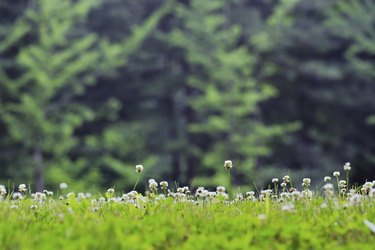
Dandelions (Taraxacum officinale) and clover (Trifolium spp.) are broad-leaved weeds, and they can be controlled with fertilizing, hand weeding or applying herbicides. Dandelions are hardy in U.S. Department of Agriculture plant hardiness zones 5 through 9, and white clover (Trifolium repens) -- a common clover weed -- is hardy in USDA zones 3 through 10. Selective herbicides for broad-leaved weeds control dandelions and clover without harming grass, and pre-emergent herbicides can help prevent dandelion and clover seeds from sprouting.
Dandelion and Clover
Video of the Day
Dandelions and clover are perennial weeds that are often difficult to control when growing in grass. Perennial weeds don't die at the end of the growing season but grow larger year after year.
Video of the Day
Dandelions are difficult to control in grass because they have deep taproots that are difficult to dig up. If any part of dandelion root is left in the soil, it regrows. Clover is difficult to control because it can sprout from any small piece of stem that's in contact with soil. Dandelions and clover also produce seeds that lie dormant, waiting for the right temperatures and moisture levels to grow.
Fertilizing Grass
Clover appears when turf grass is low in nitrogen. Clover is a nitrogen-fixing plant. It takes nitrogen from the air and turns the chemical into a plant nutrient in special nodules on its roots. In low-nitrogen conditions, grass struggles to grow, but clover succeeds. Fertilizing grass helps control clover.
Nitrogen needs vary according to the grass type, but most lawns benefit from 1 pound of actual nitrogen per 1,000 square feet, four times a year. Apply nitrogen fertilizer when the lawn is green and growing, and water the lawn afterward.
Hand Weeding
Hand weeding controls small numbers of dandelions and clover in grass. A special tool called a dandelion knife or dandelion weeder helps remove dandelions. This is a tool with a long prong to reach the bottom of the dandelion roots.
Push a dandelion weeder into the soil next to the base of a dandelion plant, and work it backward and forward to loosen the root in the ground. Push down on the handle to lever the root out of the soil.
Remove clover plants with a trowel. Lift the spreading stems to find the stem base, and push the trowel under it to lift the root ball from the soil.
Check the grass every two weeks for new dandelions and clover plants, and remove them.
Herbicide Options
Selective and pre-emergent herbicides control dandelions and clover, but several applications may be needed. Put on a long-sleeved shirt, long pants, safety goggles and gloves before applying herbicides.
On a dry, still day when the weeds are actively growing and temperatures are between 45 and 90 degrees Fahrenheit, spray the center of dandelions and clover plants with a ready-to-use selective herbicide for broad-leaved weeds, such as a product containing 0.026 percent dicamba, 0.605 percent 2, 4-D and 0.149 percent MCPP. Spray the herbicide until just before it begins to drip from the leaves.
To help prevent dandelion and clover seeds from sprouting, apply a ready-to-use pre-emergent herbicide containing 0.38 percent isoxaben at a rate of 4.6 to 5.7 pounds per 1,000 square feet. Apply the product in early spring, late summer or early fall, before dandelion and clover seeds sprout, and irrigate the lawn with 1/2 inch water.
- Plants for a Future: Taraxacum Officinale
- Oregon Urban IPM: Weeds -- Clover -- Trifolium Spp.
- Missouri Botanical Garden: Trifolium Repens
- UC Statewide IPM Online: Dandelions
- University of California Integrated Pest Management Online: Weed Management in Lawns
- Pennsylvania State University Extension: Common Dandelion
- University of Tennessee Extension: Common Herbicides for Ornamental Weed Control
- University of California Agriculture and Natural Resources: Practical Lawn Fertilization